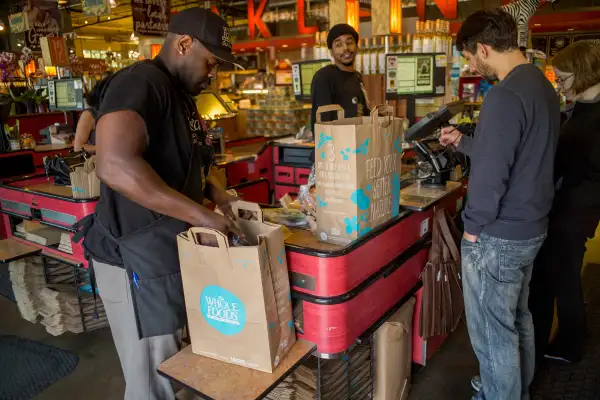This Is How Much More You'll Spend at Whole Foods vs. Trader Joe's

When it comes to bourgeoisie supermarkets, stereotypes abound. The regular Whole Foods shopper is obsessed with kale, yoga, and SoulCycle, and "Whole Paycheck" does not, in fact, cost anywhere close to his or her whole paycheck. Trader Joe's, on the other hand, is for the hipster shopper who's bougie but broke.
But what about the reality: Is Whole Foods really that much more expensive than Trader Joe's?
According to a staff writer at SFGate who recently did a cost comparison of popular items, yes. A trip to the store rounding up 30 standard supermarket items will cost you about 20% more—$133.18 as opposed to $109.27—at Whole Foods than it will at Trader Joe's. This isn't an exact apples-to-apples comparison because each store has its own brands, but you get the idea.
Previous shopping experiments have yielded similar results. A price comparison of 20 items conducted by Cheapism found that 14 of the 20 items were cheaper at Trader Joe's than Whole Foods; a DCist comparison shopping excursion found that a bag of quinoa was half the price at Trader Joe's, and a gluten-free cheese pizza was only two-thirds of the price.
As Business Insider explains it, Trader Joe's is able to undercut Whole Foods (and other supermarkets) by selling in-house products rather than brands, and by sticking to an efficient "no frills" interior in small stores. The strategy reportedly earns Trader Joe's twice the sales per square foot, and a clientele that views its products as high quality at bargain prices.
Still, while Whole Foods tends to be more expensive on average ("sometimes because the product is of a high-quality or carries Non-GMO Project verification and sometimes for no apparent reason," as SFGate pointed out), there were a number of items on the reporter's list that were priced almost identically at the two stores. Namely, 100% Florida Orange Juice, low-fat organic yogurt, apple sauce, flour, almond butter, Hell or High Watermelon beer, and Clif Bars. What's more, a basic pack of frozen organic peas was actually more expensive at Trader Joe's.
In the past year Whole Foods strategically cut prices on some items, and launched a new "values matter" slogan to appeal to consumers who have grown weary of its high prices. Whole Foods is also launching a new low-price supermarket model called 365. So one can be hopeful that the list of more affordable items at Whole Foods-owned stores may grow.
For the time being, shop where you will—but we'd recommend against splurges of the asparagus water variety.